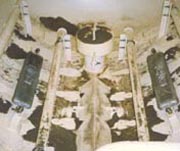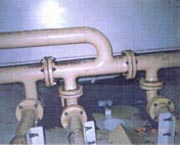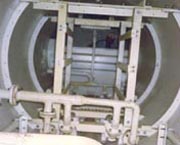Phase Separation and Demisters
As part of overall separator designs, mesh or vane pack eliminators are usually included inside separation vessels to separate liquid droplets from gas streams. Mackenzie Hydrocarbons offers design and supply of a full range of mesh and vane demisters, customized to particular applications and specifically orientated to protect the product gas.
Mesh Style Mist Eliminators
Mesh type eliminators are available in metal alloys such as stainless steel, monel, incoloy and more exotic materials such as dacron. Standard wire mesh mist eliminators are typically designed to remove 99.5% of all liquid droplets 10 micron and above. With a far greater surface area than wire mesh, dacron is more efficient at removing droplets around the 1 to 3 micron size.
Selection of Vane Eliminators
Mackenzie Hydrocarbons offers three basic styles of vane-type mist eliminators – pocketless, single pocket and double pocket. Each is best suited to its particular application. Of the three vane mist eliminator styles, pocketless mist eliminators cause the least amount of pressure drop across the eliminator element and the least chance of fouling. For vertical flow applications, the pocketless design allows coalesced liquid droplets to fall easily towards the bottom of the vessel and are best suited to the removal of viscous contaminants.
Single pocket eliminators present a pocket to the impinging stream where liquids can collect. Single pocket mist eliminators are suited for applications with high loading of non-viscous liquids.
Double pocket mist eliminators present the impinging fluid with the most tortuous pathway of the three styles. They are used in applications that require high separation efficiency or foam breakdown.
Combination Packages
The ultimate package for mist eliminators depends on the fluid, the operating conditions, the vessel design, other internals and the required product specification.
Basically, mesh pads offer good protection of the outlet gas stream, but are susceptible to fouling. Vane packs offer improved protection in their design range but sometimes struggle when the flowrate becomes unstable or fluctuates. The vane pack turndown is therefore more limited than mesh pads. The solution : use vane packs and mesh pads in tandem. With a particularly tight vessel design or very low carryover figures, a combination mesh and vane mist eliminators may be used, with the mesh eliminator usually placed forward in the stream to agglomerate fine liquid particles for subsequent capture by the vane eliminator.
If higher flowrates are expected than the original design, the solution may be to use a primary – secondary vane pack combo, since a fast velocity can foul the Mesh Pad.
Mesh Pads tend to perform better when dealing with small size particles (maybe even sub-micron) by using mesh layers of different materials.
Achieving the right combination relies on understanding the complete system. Even then, in most cases, a complete set of data is not available, so experience plays a significant role. And, over the past few years, MKZ has found a definite move toward the combo-units, mostly the Mesh Pad is located upstream, the Vane Pack downstream, as this combination covers a wider liquid particle size and a greater range of flowrates.
Computational Fluid Dynamics (CFD)
Mackenzie Hydrocarbons offers CFD, a mathematical technique for predicting the flow characteristics.



